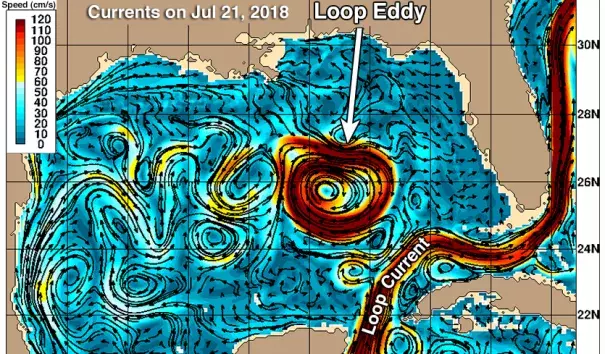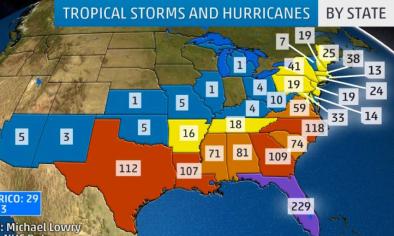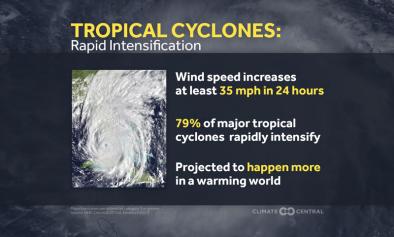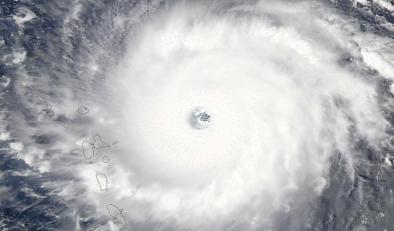High Octane Hurricane Fuel in the Gulf of Mexico: 2 Loop Current Eddies

There’s potential trouble cooking in the Gulf of Mexico for the coming peak portion of the Atlantic hurricane season: a near-record amount of heat energy in the ocean waters.
...
SSTs are 30° – 31°C (86° - 88°F) in the central and western Gulf, more than 1°C (1.8°F) above average. That’s a lot of heat in the waters for potential hurricanes to feast on.

Above: SSTs in the Gulf of Mexico on July 25, 2018 ranged from 29° – 31° C (84° – 88° F), an average of 0.6°C (1° F) above average when summed over the entire Gulf. Credit: Levi Cowan, tropicaltidbits.com
But SSTs don’t tell the whole story. When a slow-moving hurricane traverses a shallow area of warm ocean waters, the hurricane’s powerful winds will churn up cold waters from the depths, cooling the surface and putting the brakes on any rapid intensification the hurricane may have had in mind. But when unusually warm ocean waters extend to great depth—down 100 meters or more below the surface—the hurricane’s churning winds simply stir up more warm water, allowing dangerous rapid intensification to occur if wind shear is low. Last year’s trio of great hurricanes—Harvey, Irma, and Maria—all underwent rapid intensification into major hurricanes when they were located over waters with above-average SSTs, where the warm waters extended to great depth. Thus, total Ocean Heat Content (OHC) is a key metric used to determine the potential for hurricane rapid intensification.
...
In the Gulf of Mexico, the deepest warm water is found in the Loop Current--an ocean current that transports warm Caribbean water through the Yucatan Channel between Cuba and Mexico...
The Loop Current commonly bulges out in the northern Gulf of Mexico and sometimes will shed a clockwise rotating ring of warm water that separates from the main current...
When a Loop Current eddy breaks off in the Gulf of Mexico at the height of hurricane season, it can lead to a dangerous situation where a vast reservoir of energy is available to any hurricane that might cross over...
Even when a Loop Current eddy has been separated from the Loop Current for more than a year, it can still provide a potent source of heat energy for a hurricane.
Hurricane Harvey of 2017 was fueled by an old Loop Current eddy that had migrated to the coast of Texas, a full 16 months after it had broken off from the Loop Current. This heat energy contributed to Hurricane Harvey’s record rains. A 2018 paper by Kevin Trenberth of the National Center for Atmospheric Research, Hurricane Harvey Links to Ocean Heat Content and Climate Change Adaptation concluded: “The bottom line is that the total observed OHC change is remarkably compatible with the total energy released by precipitation and, unsurprisingly, reflects strong energy exchanges during the hurricane. Accordingly, the record high OHC values not only increased the latent heat which fueled the storm itself, likely increasing its size and intensity, but also likely contributed substantially to the flooding caused by rainfall on land. The implication is that if the OHC had been less, then the rainfall amounts would also have been less.”
...
A large warm eddy broke off of the Loop Current in February 2018, and has drifted slowly west-southwest during the year, arriving in late July to a position about 300 miles east of the Texas/Mexico and border and 400 miles south of western Louisiana . As if that weren’t enough, we had a new and larger warm eddy break off from the Loop Current in late June. That eddy is located a few hundred miles west of the southwest coast of Florida. Both of these eddies are capable of supplying major heat energy to tropical cyclones that might get loose in the Gulf. The total amount of heat energy in the Gulf right now is at near-record levels for this time of year—similar to last year’s levels, and far higher than what was observed during the nasty Hurricane Season of 2005.
Related Content






